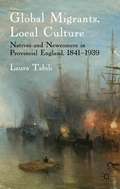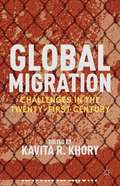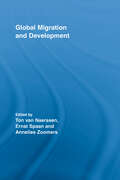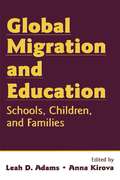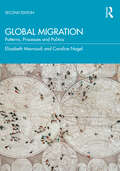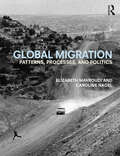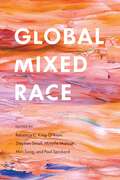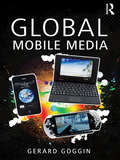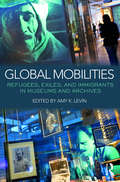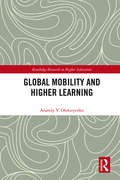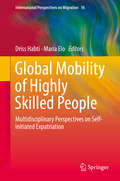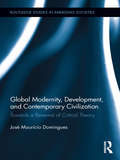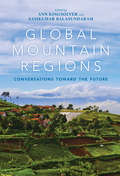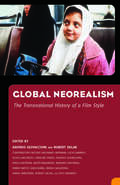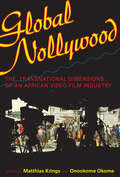- Table View
- List View
Global Migrants, Local Culture
by Laura TabiliEmploying the first analysis of the entire population of any British town, this book examines how overseas migrants affected society and culture in South Shields near Newcastle-upon-Tyne. Resituating Britain within global processes of migration and cultural change, it recasts British society pre-1940 as culturally and racially dynamic and diverse.
Global Migration
by Kavita R. KhoryImmigration today evokes passionate debates over questions of national identity, state sovereignty, and citizenship. Even as capital, goods, and services flow easily over national boundaries, human beings are subjected to intense scrutiny and resistance when crossing borders. In this collection of essays, distinguished scholars probe the challenges and opportunities that global migration presents for individuals, states, and societies grappling with questions of identity, belonging, and citizenship. Multidisciplinary in scope, the book demonstrates how forced and voluntary migrations intersect with global politics, from economic and environmental crises to human rights and security.
Global Migration Governance from Below: Actors, Spaces, Discourses (Mobility & Politics)
by Stefan RotherAfter a long time of neglect, migration has entered the arena of international politics with a force. The 2018 Global Compact for safe, orderly and regular migration (GCM) is the latest and most comprehensive framework for global migration governance. Despite these dynamics, migration is still predominantly framed as a state-centric policy issue that needs to be managed in a top-down manner. This book proposes a difference approach: A truly multi-stakeholder, multi-level and rights-based governance with meaningful participation of migrant civil society. Drawing on 15 years of participant observation on all levels of migration governance, the book maps out the relevant actors, “invited” and “invented” spaces for participation as well as alternative discourses and framing strategies by migrant civil society. It thus provides a comprehensive and timely overview on global migration governance from below, starting with the first UN High Level Dialogue in 2006, evolving around the Global Forum on Migration and Development (GFMD) and leading up to the consultations for the International Migration Review Forum in 2022.
Global Migration and Development (Routledge Studies in Development and Society)
by Ton Van Naerssen Ernst Spaan Annelies ZoomersThe debate on international migration and development currently focuses on South-North migration, transnationalism, remittances and knowledge transfer. The potential positive role of migration for countries and regions the emigrants originate from has recently been acknowledged by, among others, the World Bank, United Nations Commissions and the International Organisation for Migration (IOM). This volume addresses the question: to what extent and under what conditions does international migration contribute to local and national development? By presenting novel insights and themes on the basis of new empirical evidence from various countries, this volume is an indispensable addition to the international discussion on migration.
Global Migration and Education: Schools, Children, and Families
by Anna Kirova Leah AdamsGlobal Migration and Education makes a notable contribution to understanding the issues faced by immigrant children, their parents, and educators as they interact in school settings, and to identifying the common challenges to, and successes in, educational institutions worldwide as they cope with these issues. Global in scope, there are chapters f
Global Migration and the World Economy: Two Centuries of Policy and Performance
by Jeffrey G. Williamson Timothy J. HattonThis book is the first comprehensive economic assessment of world mass migration taking a long-run historical perspective, including north-north, south-south, and south-north migrations.
Global Migration, Ethnicity and Britishness
by Tariq Modood John SaltExploring the most topical issues around migration and integration in relation to Britain, this book, now in paperback, examines people smuggling and the elite labour migration that is becoming a feature of Britain. It also examines the concepts of social capital, social cohesion and Britishness that are being used to critique multiculturalism.
Global Migration: Patterns, Processes and Politics
by Elizabeth Mavroudi Caroline NagelThis new, fully updated edition of Global Migration provides students with a thorough and grounded understanding of multiple dimensions of migration, including labour markets, citizenship, border control, integration and identity. Written by two geographers, the book incorporates insights from across the social sciences and is accessible to students in many disciplines. Providing a useful and timely introduction to migration, the textbook addresses migration in a holistic way and equips students with the tools they need to participate in contemporary debates about migration in sending and destination contexts. It conveys to students that the causes and effects of migration are geographically specific and contingent upon class, race, gender and other markers of social difference. Rather than identifying simple solutions to migration ‘problems’, the book encourages students to think about unauthorized migration, asylum, refugee resettlement, labour migration, and other forms of mobility (and immobility) from different vantage points. Global Migration serves as the go-to book for teaching advanced undergraduate and master’s-level students about the complexities of migration across nation-state borders.
Global Migration: Patterns, processes, and politics
by Elizabeth Mavroudi Caroline NagelGlobal Migration provides a clear, concise, and well-organized discussion of historical patterns and contemporary trends of migration, while guiding the readers through an often difficult and politicised topic. Aimed primarily at undergraduate and Master’s students, the text encourages the readers to reflect on economic processes, politics, immigrant lives and raises debates about inclusion, exclusion, and citizenship. The text critically highlights the global character of contemporary migration and the importance of historical context to current processes and emphasises the role of gender, race and national ideologies in shaping migration experiences.? Using over a decade of their own insight into teaching undergraduate migration courses in the US and the UK, and the knowledge and understanding of the subject they have acquired as migration researchers, the authors offer an accessible and student-friendly manner for readers to understand and explore the complex issue of migration. The book features numerous international case studies, a chapter dedicated to the perspective of the immigrants themselves, as well as key terms and further readings at the end of each chapter.? Both theoretically and empirically informed Global Migration examines the subject in a holistic and expansive way. It will equip students with an understanding of the complex issues of migration and serve as a guide for instructors in structuring their courses and in identifying important bodies of scholarly research on migration issues.
Global Migration: The Basics (The Basics)
by Bernadette Hanlon Thomas J. VicinoMigration is a politically sensitive topic and an important aspect of contentious debates about social and cultural diversity, economic stability, terrorism, globalization, and nationalism. Global Migration: The Basics examines: history and geography of global migration the role of migrants in society impact of migrants on the economy and the political system policy challenges that need to be faced in confronting a rapidly changing world economy and society. This book challenges students of geography, political science, public policy, sociology, and economics to look beyond the rhetoric and consider the real and basic facts about migration. Through detailed examinations of the scholarly literature, demographic patterns, and public policy debates, Global Migration: The Basics exposes readers to the underlying causes and consequences of migration.
Global Mixed Race
by Paul Spickard Minelle Mahtani Stephen Small Miri Song Rebecca C. King-O’RiainPatterns of migration and the forces of globalization have brought the issues of mixed race to the public in far more visible, far more dramatic ways than ever before. Global Mixed Race examines the contemporary experiences of people of mixed descent in nations around the world, moving beyond US borders to explore the dynamics of racial mixing and multiple descent in Zambia, Trinidad and Tobago, Mexico, Brazil, Kazakhstan, Germany, the United Kingdom, Canada, Okinawa, Australia, and New Zealand. In particular, the volume’s editors ask: how have new global flows of ideas, goods, and people affected the lives and social placements of people of mixed descent? Thirteen original chapters address the ways mixed-race individuals defy, bolster, speak, and live racial categorization, paying attention to the ways that these experiences help us think through how we see and engage with social differences. The contributors also highlight how mixed-race people can sometimes be used as emblems of multiculturalism, and how these identities are commodified within global capitalism while still considered by some as not pure or inauthentic. A strikingly original study, Global Mixed Race carefully and comprehensively considers the many different meanings of racial mixedness.
Global Mobile Media
by Gerard GogginGerard Goggin has produced an incisive and penetrating overview of the world according to mobiles. Covering sight, sound and status, plus a host of other issues, he provides a provocative analysis of how mobile communication gadgets come to play such a prominent role in our lives. Any scholar of New Media will want to read this book – James Katz, Department of Communication, Rutgers University, USA With billions of users worldwide, the cell phone is not only a successful communications technology; it is also key to the future of media. Global Mobile Media offers an overview of the complex topic of mobile media, looking at the emerging industry structures, new media economies, mobile media cultures and network politics of cell phones as they move centre-stage in media industries. The development, adoption and significance of cell phones for society and culture have been registered in a growing body of work. Where existing books have focused on communication, and on the social and cultural aspects of mobile media, Global Mobile Media looks at the media dimensions. Goggin provides a pioneering yet measured evaluation of how cell phone corporations, media interests, users and policy makers are together shaping a new media dispensation. Global Mobile Media successfully places new mobile media historically, socially and culturally in a wider field of portable media technologies through extensive case studies, including: the rise of smartphones, with a detailed discussion of the Apple iPhone and how it has catalysed a new phase in convergent media, audiences and innovation the new agenda in cultural politics and media policy, featuring topics such as iPhone apps and control, mobile commons, and open mobile networks a succinct map of the political economy of mobile media, identifying key players, patterns of ownership and control, institutions, and issues a critical account of cell phones’ involvement in and contribution to much-discussed new forms of production and consumption, such as user-generated content, p2p networks, open and free source software networks an anatomy of how cell phones relate to other online media, particularly the Internet and wireless technologies. Global Mobile Media is an engaging, accessible text which will be of immense interest to upper-level undergraduates, postgraduates and researchers in Communication Studies, Cultural Studies and Media Studies, as well as those taking New Media courses.
Global Mobilities: Refugees, Exiles, and Immigrants in Museums and Archives
by Amy K. LevinGlobal Mobilities illustrates the significant engagement of museums and archives with populations that have experienced forced or willing migration: emigrants, exiles, refugees, asylum seekers, and others. The volume explores the role of public institutions in the politics of integration and cultural diversity, analyzing their efforts to further the inclusion of racial and ethnic minority populations. Emphasizing the importance of cross-cultural knowledge and exchange, global case studies examine the conflicts inherent in such efforts, considering key issues such as whether to focus on origins or destinations, as well as whether assimilation, integration, or an entirely new model would be the most effective approach. This collection provides an insight into diverse perspectives, not only of museum practitioners and scholars, but also the voices of artists, visitors, undocumented immigrants, and other members of source communities. Global Mobilities is an often provocative and thought-inspiring resource which offers a comprehensive overview of the field for those interested in understanding its complexities.
Global Mobility Regimes
by Rey KoslowskiThis volume considers 'global mobility' as an alternative concept to 'international migration' in order to gain insights into international cooperation on movements of people across international borders.
Global Mobility and Higher Learning (Routledge Research in Higher Education)
by Anatoly OleksiyenkoThis book examines learning-mobility tensions and ties caused by convergences and divergences of social, organizational and cognitive forces in global higher education. As some of these forces generate status anxiety, and others enhanced self-worth, this volume asks the questions: How can students navigate treacherous education markets to reduce the former and increase the latter? Which specific forces and confluences enhance the quality of self-discovery? Does the search for identity and meaning produce better results when conducted internationally? Which transformative drivers of global mobility enhance social mobility? What allows some students to gain the capacity for impactful higher learning at a time when others lose it? Why are strategically minded students increasingly concerned about equality and the quality of contribution to the common good of education, rather than about their own status? What makes some places of learning stand out when students recount their journeys of self-discovery and roads to self-worth? This book includes a broad range of stories and firsthand perspectives that are often overlooked in the process of internationalization of higher education. The narratives offer important insights to consider, given the ever-increasing disquiets of competitiveness-oriented global higher education.
Global Mobility of Highly Skilled People: Multidisciplinary Perspectives on Self-initiated Expatriation (International Perspectives on Migration #16)
by Maria Elo Driss HabtiThis volume examines self-initiated expatriates (SIEs), the category of highly skilled people whose movement from one country to another is by choice. Although they are not forced to relocate due to work, conflict or natural disaster, their migration pattern is every bit as complex. The book challenges previous theoretical approaches that take for granted a more simplistic view of this population, and advances that mobility of SIEs relates to the expatriates themselves, their conditions and the different structures intervening in their career life course. With their visible increase worldwide, this book positions itself as a nexus for this on-going discussion, while linking self-initiated expatriation to the theoretical landscape of international skilled migration and mobility. Major interests that catch attention are transnational practices, work-related experiences and personal life course, including forms of inequalities in their migration experiences. The book identifies forms and drivers of migratory behaviour and provides an argument concerning the broader processes of mobility and integration. As such, this book constitutes a departure point for future research in terms of theoretical underpinnings and empirical rigor on global highly skilled mobility of SIEs. The collection of empirical case studies offers an insightful analysis for policy makers, concerned stakeholders and organizations to better cope with this form of migration.
Global Modernity, Development, and Contemporary Civilization: Towards a Renewal of Critical Theory (Routledge Studies in Emerging Societies)
by José Maurício DominguesThis book investigates modern global civilization, offering an alternative to post-colonial theories and the "multiple modernities" approach (as well as the civilizational theory linked to it). It argues that modernity has become a global civilization that is heterogeneous and intertwined with other civilizations, and also aims at a renewal of critical theory that is not US-centric and Eurocentric, focusing instead on China, South Asia (India) and Latin America (Brazil). Dealing with the themes of centre-periphery relations, complexity (including culture and religion), democracy and emancipatory possibilities, this book is based on general theoretical ideas such as collective subjectivity, the interplay of memory and creativity, and the concept of "modernizing moves," so as to deal with historical contingency.
Global Monitoring Report 2013: Rural-Urban Dynamics and the Millennium Development Goals
by the editors at The World BankThe Global Monitoring Report 2013: Rural-Urban Dynamics and the Millennium Development Goals examines rural-urban disparities in the achievement of the Millennium Development Goals (MDGs) and how urbanization, if managed well, can contribute to the attainment of these goals. The report provides information about the differences in progress toward the MDGs across geographical areas and recognizes that urban populations are better off than their rural brethren. However, unfettered urbanization can cause migrants and the urban poor to end up in slums where attainment of the MDGs lags. GMR 2013 calls for an integrated strategy to better manage the planning-connecting-financing formula of urbanization. Notwithstanding the importance of urbanization in poverty reduction and MDG attainment, rural areas remain a huge challenge—one that underscores the importance of policies that can improve rural livelihoods. The rural-urban spectrum ranges from small towns to large cities. The general experience is that poverty is lowest in the largest cities and considerably higher in smaller towns. The MDGs reflect the basic needs of all citizens, and governments should aim to meet them fully in both urban and rural areas. However, resources are scarce, so priorities must be set and trade-offs made. The report argues that the sequencing of actions be tailored to local conditions when it comes to the degree of urbanization and rural-urban differences in MDG outcomes. The world has met four global MDG targets. New estimates confirm the 2012 reports that MDG 1.a—reducing the $1.25-a-day poverty rate (2005 purchasing power parity)—was reached in 2010, falling below half of its 1990 value. The world also met part of MDG 7.c—to halve the proportion of people without safe access to drinking water—in 2010. MDG 7.d—to improve significantly the lives of at least 100 million slum dwellers by 2020—was also achieved. Finally, the first part of MDG 3.a—to eliminate gender disparity in primary education— was accomplished in 2010. Global progress on the full MDG 3.a (to eliminate gender disparity in primary and secondary education) is close to being on track. Global Monitoring Report 2013 was prepared jointly by the World Bank and the International Monetary Fund, with consultations and collaborations with regional development banks and other multilateral partners. Show more
Global Mountain Regions: Conversations toward the Future (Framing the Global)
by Ann Kingsolver Sasikumar BalasundaramNo matter where they are located in the world, communities living in mountain regions have shared experiences defined in large part by contradictions. These communities often face social and economic marginalization despite providing the lumber, coal, minerals, tea, and tobacco that have fueled the growth of nations for centuries. They are perceived as remote and socially inferior backwaters on one hand while simultaneously seen as culturally rich and spiritually sacred spaces on the other. These contradictions become even more fraught as environmental changes and political strains place added pressure on these mountain communities. Shifting national borders and changes to watersheds, forests, and natural resources play an increasingly important role as nations respond to the needs of a global economy. The works in this volume consider multiple nations, languages, generations, and religions in their exploration of upland communities’ responses to the unique challenges and opportunities they share. From paintings to digital mapping, environmental studies to poetry, land reclamation efforts to song lyrics, the collection provides a truly interdisciplinary and global study. The editors and authors offer a cross-cultural exploration of the many strategies that mountain communities are employing to face the concerns of the future.
Global Mountain Regions: Conversations toward the Future (Framing the Global)
by Edited by Ann Kingsolver and Sasikumar BalasundaramWorks exploring the responses of global mountain communities to the shared challenges and opportunities their unique locations afford them.No matter where they are located in the world, communities living in mountain regions have shared experiences defined in large part by contradictions. These communities often face social and economic marginalization despite providing the lumber, coal, minerals, tea, and tobacco that have fueled the growth of nations for centuries. They are perceived as remote and socially inferior backwaters on one hand while simultaneously seen as culturally rich and spiritually sacred spaces on the other. These contradictions become even more fraught as environmental changes and political strains place added pressure on these mountain communities. Shifting national borders and changes to watersheds, forests, and natural resources play an increasingly important role as nations respond to the needs of a global economy.The works in this volume consider multiple nations, languages, generations, and religions in their exploration of upland communities’ responses to the unique challenges and opportunities they share. From paintings to digital mapping, environmental studies to poetry, land reclamation efforts to song lyrics, the collection provides a truly interdisciplinary and global study. The editors and authors offer a cross-cultural exploration of the many strategies that mountain communities are employing to face the concerns of the future.“Global Mountain Regions is an outstanding addition to the inventory of the interdisciplinary field of montology, the study of mountains. For any scholar or student interested in the human dimensions of mountain regions, many if not all of the essays will be valuable references.” —American Ethnologist
Global Movie Magazine Networks
by Eric Hoyt and Kelley ConwayA free ebook version of this title is available through Luminos, University of California Press’s Open Access publishing program. Visit www.luminosoa.org to learn more. This groundbreaking collection of essays from leading film historians features original research on movie magazines published in China, France, Germany, India, Iran, Latin America, South Korea, the U.S., and beyond. Vital resources for the study of film history and culture, movie magazines are frequently cited as sources, but rarely centered as objects of study. Global Movie Magazine Networks does precisely that, revealing the hybridity, heterogeneity, and connectivity of movie magazines and the important role they play in the intercontinental exchange of information and ideas about cinema. Uniquely, the contributors in this book have developed their critical analysis alongside the collaborative work of building digital resources, facilitating the digitization of more than a dozen of these historic magazines on an open-access basis.
Global Muckraking
by Anya SchiffrinCrusading journalists from Sinclair Lewis to Bob Woodward and Carl Bernstein have played a central role in American politics: checking abuses of power, revealing corporate misdeeds, and exposing government corruption. Muckraking journalism is part and parcel of American democracy. But how many people know about the role that muckraking has played around the world?This groundbreaking new book presents the most important examples of world-changing journalism, spanning one hundred years and every continent. Carefully curated by prominent international journalists working in Asia, Africa, Latin America, Europe, and the Middle East, Global Muckraking includes Ken Saro-Wiwa's defense of the Ogoni people in the Niger Delta; Horacio Verbitsky's uncovering of the gruesome disappearance of political detainees in Argentina; Gareth Jones's coverage of the Ukraine famine of 1932-33; missionary newspapers' coverage of Chinese foot binding in the nineteenth century; Dwarkanath Ganguli's exposé of the British "coolie" trade in nineteenth-century Assam, India; and many others.Edited by the noted author and journalist Anya Schiffrin, Global Muckraking is a sweeping introduction to international journalism that has galvanized the world's attention. In an era when human rights are in the spotlight and the fate of newspapers hangs in the balance, here is both a riveting read and a sweeping argument for why the world needs long-form investigative reporting.
Global Navigation Satellite Systems and Their Applications (SpringerBriefs in Space Development)
by Scott MadryProfessor Madry, one of the world's leading experts in the field of the practical applications of satellites and space technologies, provides in a condensed form, a quick yet comprehensive overview of all aspects of satellite navigation. This new edition concisely addresses the latest breakthrough technologies, the various national systems, the many applications, the regulatory issues, and the strategic implications of satellite navigation systems. The future directions of autonomous aircraft and the role drones play in satellite navigation networks are also evaluated. Moreover, the industry's strengths and weaknesses are discussed, as well as reviews of all the various national systems now being deployed. The motivation behind the proliferation of these systems, in this book, evaluates the overall societal and ethical issues of these invisible yet pervasive parts of our modern digital world.
Global Neorealism: The Transnational History of a Film Style
by Saverio GiovacchiniContributions by Nathaniel Brennan, Luca Caminati, Silvia Carlorosi, Caroline Eades, Saverio Giovacchini, Paula Halperin, Neepa Majumdar, Mariano Mestman, Hamid Naficy, Sada Niang, Masha Salazkina, Sarah Sarzynski, Robert Sklar, and Vito ZagarrioIntellectual, cultural, and film historians have long considered neorealism the founding block of post-World War II Italian cinema. Neorealism, the traditional story goes, was an Italian film style born in the second postwar period and aimed at recovering the reality of Italy after the sugarcoated moving images of fascism. Lasting from 1945 to the early 1950s, neorealism produced world-renowned masterpieces such as Roberto Rossellini's Roma, città aperta (Rome, Open City, 1945) and Vittorio De Sica's Ladri di biciclette (Bicycle Thieves, 1947). These films won some of the most prestigious film awards of the immediate postwar period and influenced world cinema. This collection brings together distinguished film scholars and cultural historians to complicate this nation-based approach to the history of neorealism. The traditional story notwithstanding, the meaning and the origins of the term are problematic. What does neorealism really mean, and how Italian is it? Italian filmmakers were wary of using the term and Rossellini preferred "realism." Many filmmakers confessed to having greatly borrowed from other cinemas, including French, Soviet, and American. Divided into three sections, Global Neorealism examines the history of this film style from the 1930s to the 1970s using a global and international perspective. The first section examines the origins of neorealism in the international debate about realist esthetics in the 1930s. The second section discusses how this debate about realism was “Italianized” and coalesced into Italian “neorealism” and explores how critics and film distributors participated in coining the term. Finally, the third section looks at neorealism’s success outside of Italy and examines how film cultures in Latin America, Africa, Asia, and the United States adjusted the style to their national and regional situations.
Global Nollywood: The Transnational Dimensions of an African Video Film Industry (African Expressive Cultures)
by Matthias Krings and Onookome Okome“Reveals in fascinating detail the wild popularity, controversies, and complaints provoked by this film form . . . shap[ing] the media landscape of Africa.” —Brian Larkin, Barnard CollegeGlobal Nollywood considers this first truly African cinema beyond its Nigerian origins. In fifteen lively essays, this volume traces the engagement of the Nigerian video film industry with the African continent and the rest of the world. Topics such as Nollywood as a theoretical construct, the development of a new, critical film language, and Nollywood’s transformation outside of Nigeria reveal the broader implications of this film form as it travels and develops. Highlighting controversies surrounding commodification, globalization, and the development of the film industry on a wider scale, Global Nollywood gives sustained attention to Nollywood as a uniquely African cultural production.“Offers original material with respect to the transnational presence of Nollywood.” ?Moradewun Adejunmobi, University of California, Davis“Unveils a fascinating variety of the ways in which Nollywood cinema is viewed and interpreted.” ?Research in African Literatures“Delightfully entertaining yet appropriately erudite. . . . A welcome addition to the fields of film, media, African, and cultural studies.” —Cinema Journal“Highly recommended.” ?Choice“[T]he cumulative effect of [these] studies is to provide invaluable information for those wishing to keep up with where African cinema is today.” ?Journal of African History“Global Nollywood represents the most up-to-date research on Nollywood as a transnational cultural practice and is a must-read for scholars and students of African screen media.” —African Studies Review“Ground-breaking. . . . It proves that, in spite of appearing to be a niche market, Nollywood . . . can no longer be excluded from the canon of African cinema in the field of film studies.” ?African Affairs
